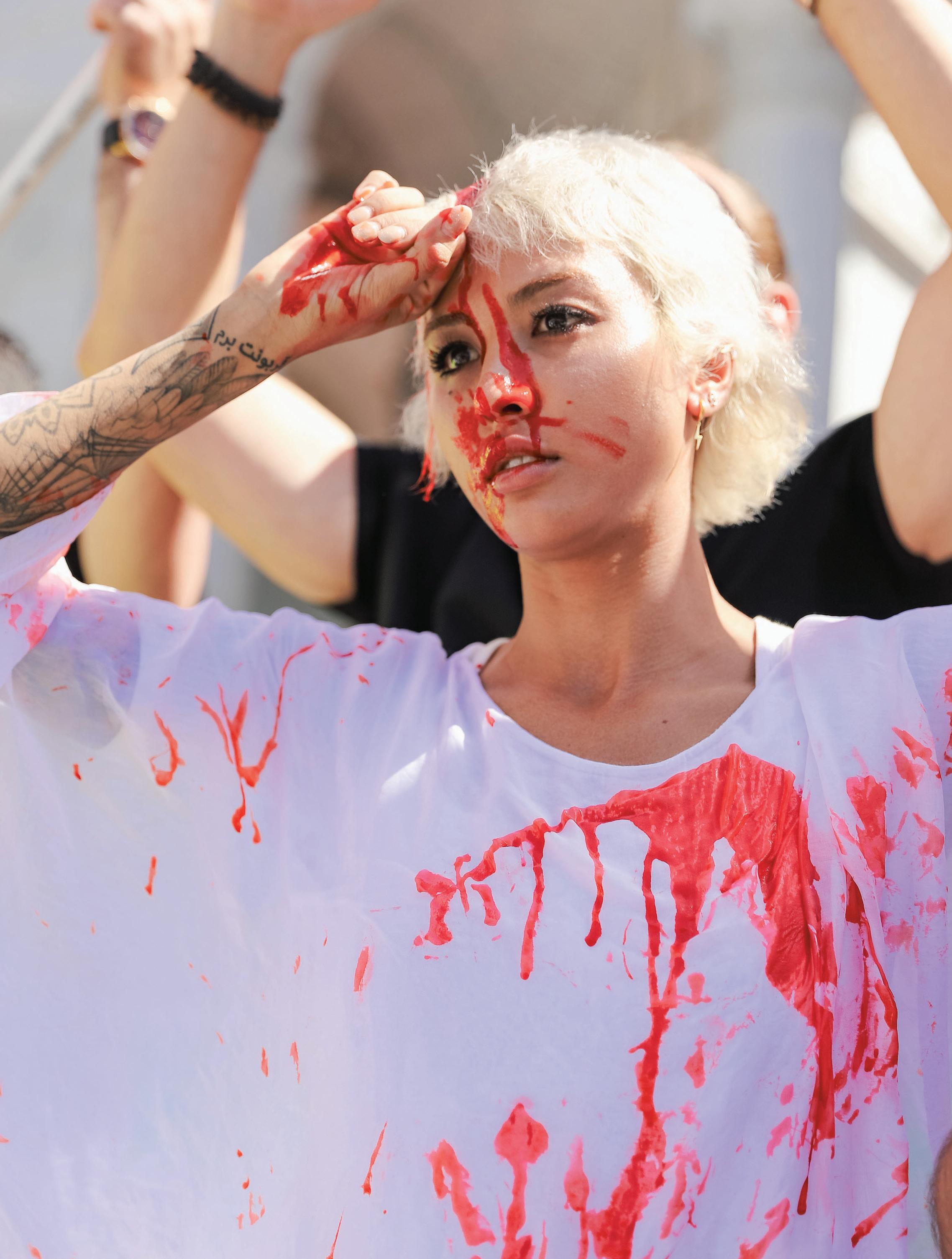
the Fall 2022/Winter 2023
BULL
Roe v Wade 12 Toxic Substances 6 Freedom For Iran 18
SOCIAL JUSTICE ISSUE
Letter from the Editor
When the Supreme Court overturned Roe v. Wade this summer, I knew that it would be a history-making, world-shattering event which effects may shift the cultural paradigm and ripple through generations. As the newly appointed editor in chief of The Bull mag, the idea of covering various social justices and injustices that impact contemporary society intrigued me.
To cover all the social injustices in our country alone would require multiple issues of a magazine. Hopefully, with this social justice issue, people can be made aware of causes that people are fighting for that they may not have thought about before. Some articles in this issue are very big, crosscontinent movements, like the Mahsa Amini protests, while others are local consequences of the nuclear testing sites in the San Fernando Valley.
Meanwhile, some articles are about people who are doing their personal best to make the world a more just place, like photojournalist Julio Cortez and Dean of Student Engagement at Pierce Juan Carlos Astorga.
Putting together these articles and learning about all the people fighting in the name of social justice gives me hope that people have the power to make the world a better place.
 Fabiola Carrizosa
Photo by David Pashaee, June 12, 2022
Front and back covers by Benjamin Hanson
Fabiola Carrizosa
Photo by David Pashaee, June 12, 2022
Front and back covers by Benjamin Hanson
STAFF
Fabiola Carrizosa
Editor in Chief
Jennifer Tanzil Reporter
Kyanna Hojati Reporter, Photographer and Social Media Editor
Poupy Gaelle Nguetsop Reporter
Eli Manzanares Reporter
Arwen Dominguez Photographer
Benjamin Hanson Photographer and Reporter
David Pashaee Photographer
Rachael Rosenberg Photographer
Raquel Frohlich Photographer
Jeff Favre Adviser
Jill Connelly Adviser

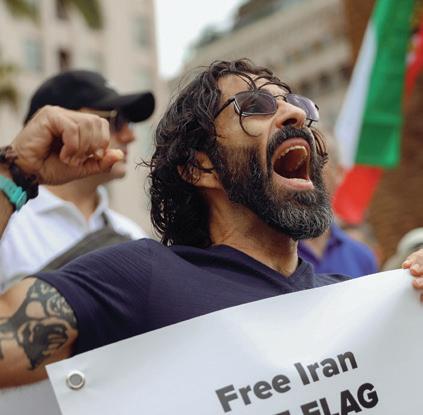




4 thebullmag.com Table of Contents 6 Poisoned in the Valley 12 The nurse with the green bandana 17 Abortion resources 18 Freedom for Iran 21 Iranian Unity at Pierce College 22 An Allstar organization



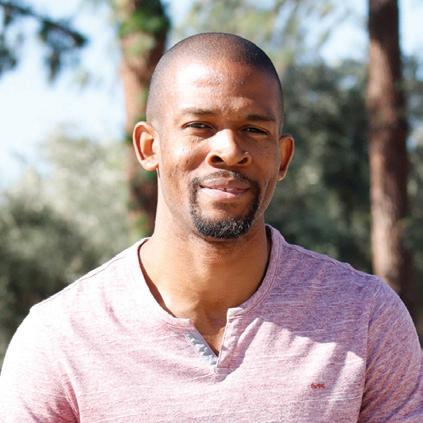


Contents Social Justice 5
27 Pierce’s tio
28 Meeting basic needs
30 Ruining the runway routine
32 Julio Cortez
33 Tia Chucha’s Centro Cultural
34 Pierce resources
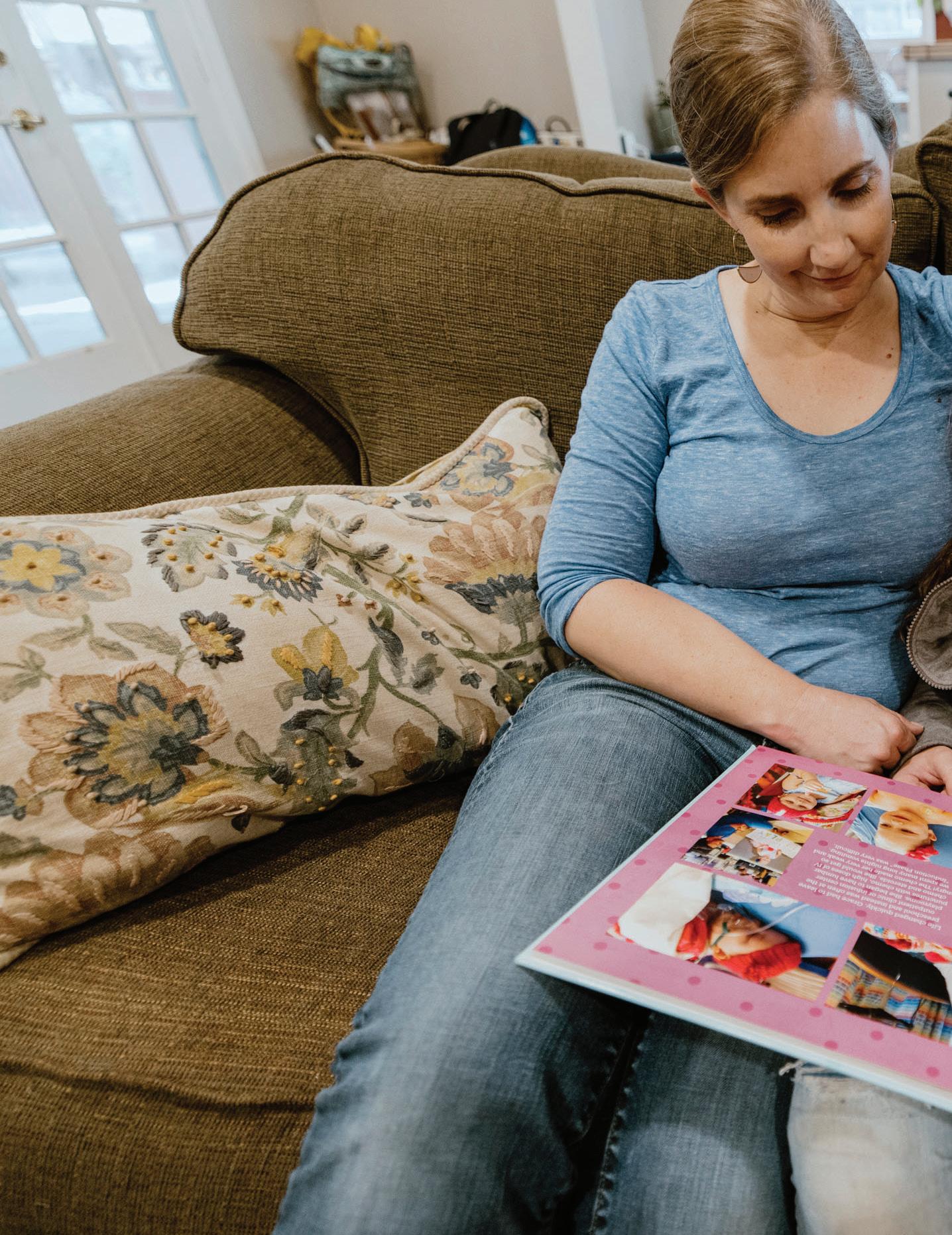 Melissa and Grace Bumstead look at photos of when Grace was hospitalized. Photo by David Pashaee on Nov. 1, 2022.
Melissa and Grace Bumstead look at photos of when Grace was hospitalized. Photo by David Pashaee on Nov. 1, 2022.
Poisoned in the Valley
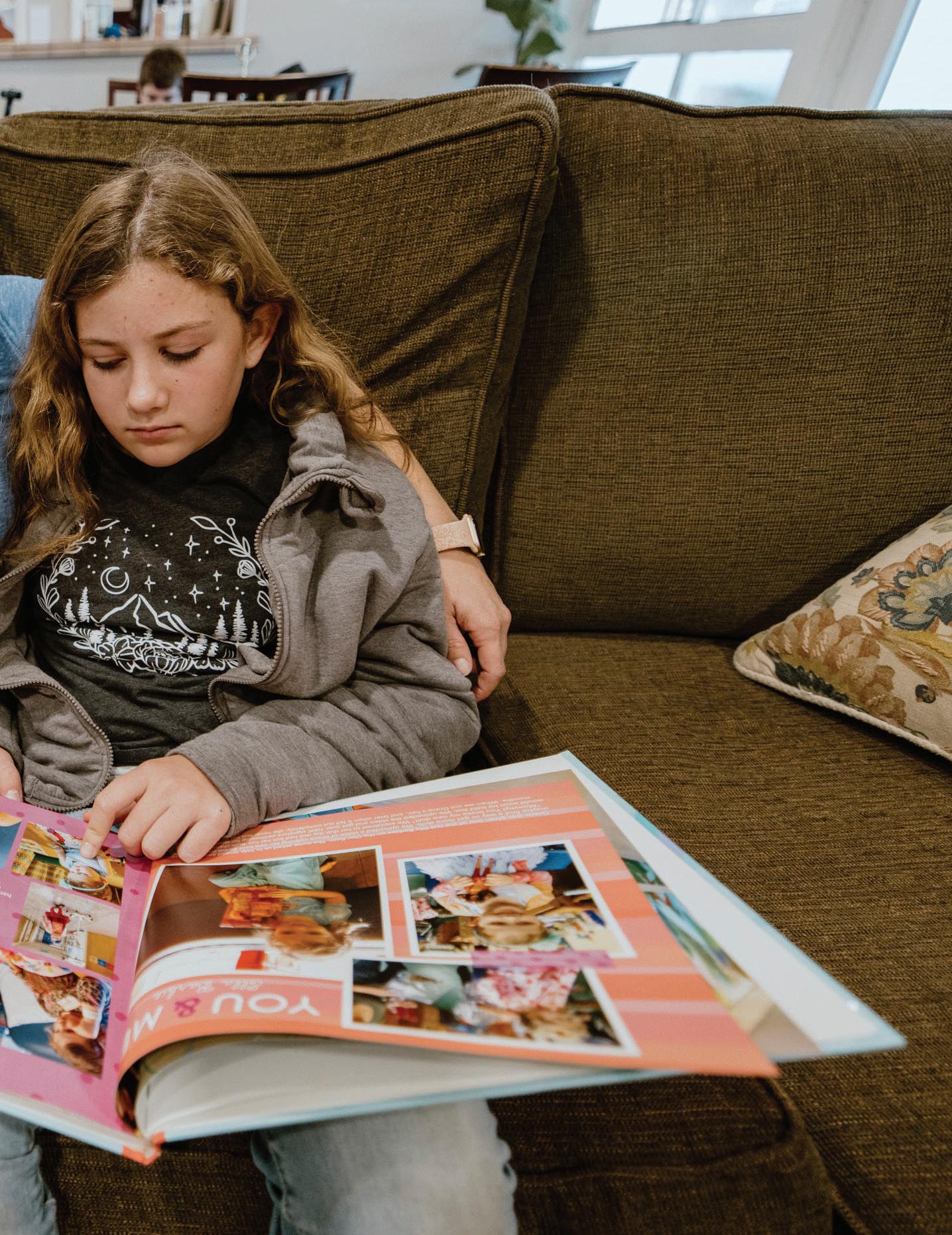 Story by Kyanna Hojati
Photos by David Pashaee and Kyanna Hojati
Story by Kyanna Hojati
Photos by David Pashaee and Kyanna Hojati
In 2014, when Grace Bumstead had just turned 4 years old, her mother Melissa Bumstead started noticing bruises.
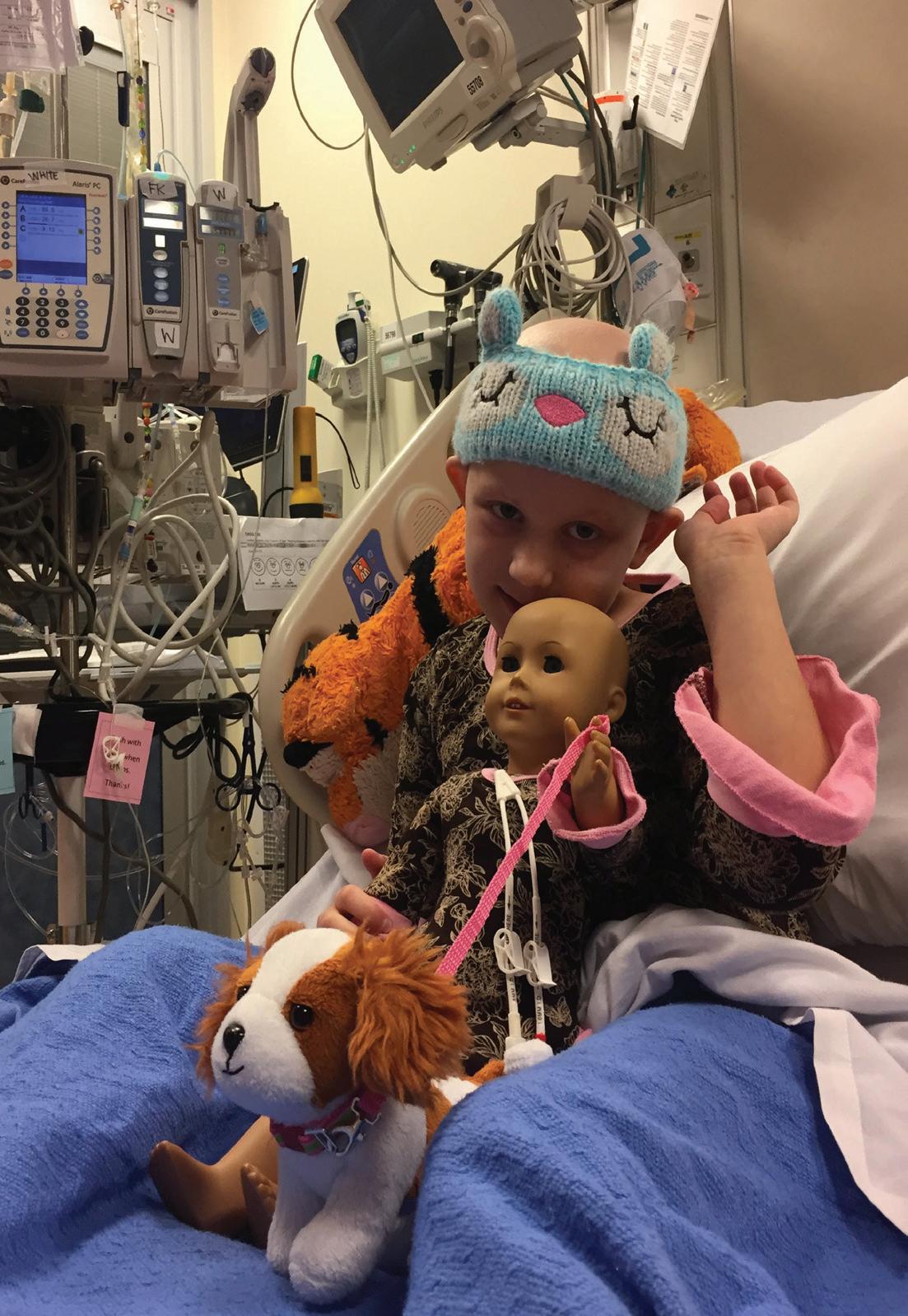

At the time, Melissa recalled not thinking much of it. “She was super active, so I thought it was normal for her age,” she said.
However, the small bruises spread and began covering the sides of the girl’s body.
Melissa hastily took her daughter to a pediatrician..
Within a few days they had confirmed that it was not only cancer, but it was a rare and aggressive form of leukemia called Ph-positive ALL.
From that point, the dynamic shifted for the Bumstead’s, with their purpose shifting toward ensuring Grace’s survival. Melissa and Grace spent weeks living at Children’s Hospital in Los Angeles, while her husband and son remained at home and visited regularly.
“It was all consuming, no time to hardly eat, think or sleep,” Melissa said. “Everything was about protecting Grace and making sure she got the right treatment.”
Grace credits her family during that time of isolation from the majority of the world— specifically her mother— with keeping her spirits lifted.
“I feel like a lot of my emotional happiness depends on my mom because I’ve been with her so much,” Grace said.
During that time, Melissa began building community and friendship with other parents. What she didn’t expect through these bonds, were a series of eerie coincidences that caught her attention.
As Melissa began conversing with parents, she began to learn that many of these families lived within her area, some as close as living on the same street.
“We got to the point where we met a family on our avenue ... three kids, within a three-year period all on the same street,” she said. This began to eat at Melissa, who knew that child cancer rates are “15,000 new cases in America a year out of 72,000,000 children,” according to the American Childhood Cancer Association.
Melissa created a group chat with the parents, and together they began mapping themselves. All of
their homes surrounded the Santa Susana Mountains, but the group remained unaware of the once deadly Rocketdyne and nuclear testing site, until one mother spoke up nearly a year later.
Melissa was blindsided with the new information, as she had never heard of the field lab when searching for answers. The parents began to realize that all of the children lived within 10 miles of the lab.
“Just from kids we know and have met, about 80 children we’ve tracked so far, and that’s without even really trying,” Melissa said.
Whispers about the Santa Susana Field Lab have been sparsely shared throughout the decades.
The Santa Susana Field Lab began its site operations in 1946 with Rocket Engine testing, eventually expanding into the field of nuclear energy. In 1959, 30 out of the 43 fuel rods in the sodium reactor experiment failed due to the core overheating.
The meltdown released 20 times the amount of radioactive gasses than the Three Miles Island accident, according to the United States Nuclear Regulatory Commission, which they called the “most serious accident in U.S. commercial nuclear power history.”
The field lab was eventually
8 thebullmag.com
Left: Grace Bumstead during her cancer treatments at Children’s Hospital Los Angeles. Photo courtesy of Melissa Bumstead.
purchased in 1996 by multinational aerospace company Boeing.
Boeing, NASA and the Department of Energy have been ordered into clean up contracts for the site, issued in 2007 and 2010 respectively. But these agreements have not been fulfilled.
The toxic substances used during testing and experimentation include rocket fuel (perchlorate), TCE (trichloroethylene) and MMH (monomethylhydrazine), all of which can lead to rare forms of cancer, immune diseases, as well as reproductive and respiratory issues, according to the preliminary assessment and site inspection report distributed by the Environmental Protection Agency.
Unknowingly, Melissa who discovered the connection between her daughter and dozens of children by accident, would lead as the face against those responsible for polluting the surrounding communities.

“If I don’t try, then when the kids after us get cancer, I won’t be able to look at them and say I tried… and that really haunted me,” Melissa said.
Melissa created a website, Parents Against Santa Susana Field Lab (parentsagainstssfl.org). Through the website, readers can see upcoming board meetings, personal statements and legal documentation that proves the toxic chemicals and waste that was left behind.

“Our main goal is to take that really complicated information,
and make it really accessible to the public,” she said.
Melissa created an online petition vying for clean up of the former field lab, gaining more than 750,000 signatures. In addition, she and other cleanup activists are continuing to seek the legal measures needed for an eventual clean up.
Through this petition, Melissa’s story has led to a series of opportunities to be heard. In 2021, she co-starred in an Emmy nominated documentary, In The Dark of the Valley. The film tells the history of the Santa Susana Field Lab dating back to its opening, and the many organizations who are fighting for the responsible parties to be held accountable.
She was most recently photographed by People Magazine, sharing her family’s personal struggle with cancer and experience with the former field lab.
Melissa’s role consists of daily meetings based on planning protests, advocating on social media, and working with other organizations to legally challenge
Social Justice 9
Above: Melissa Bumstead at her home in West Hills, Calif., on Nov. 1.
Photo by David Pashaee.
Below: Santa Susana Field Lab. Photo courtesy of William Preston Bowling.
Left: Melissa Bumstead holds her daughter Grace’s beads from her Cancer treatments in West Hills., on Oct. 13. Each bead represents a different step in Grace’s cancer journey. Photo by Kyanna Hojati.
for a clean up.
Melissa said it is unfortunate that such measures have to be taken by residents, rather than being able to trust the government’s Department of Toxic Substances Control to put the people first.
“It’s not fair that the community has to pick up the slack,” she said. “If someone had done this maybe 10 years ago, then maybe my daughter wouldn’t have gotten cancer.”
In those years, Melissa said that Boeing has never legally challenged her for saying the corporation refused to admit their role in not cleaning up the toxic site.
“I have never been served a cease and desist order,” she said. “If I was lying, that would be the first thing at my door.”
Throughout her search for answers, Melissa contacted other groups seeking to get Boeing to clean up the lab. She met Associate Director for Physicians for Social Responsibility LA Denise Duffield, which pairs health professionals with the front line communities’ lived experience.
Duffield said Santa Susana is one of the many cases of environmental causes affecting the people.
“The root cause isn’t in the body. The root cause is in the environment,” Duffield said. “The main issue is the site is contaminated. It is grossly contaminated with hazardous chemicals and dangerous radionuclides that are in the soil, that are in the groundwater, that are in the surface water run off after it rains, and when people are exposed to those contaminants they get sick.”
Duffiled said that even though the Santa Susana location ranked near the bottom of choices for the lab because of its terrain and the direction the wind blows, it was chosen for its proximity to UCLA.
“This place is really located
close to where people are, and it wasn’t supposed to be,” she said. “[The atomic energy commission] were looking for a site away from populated areas because they knew they were going to be doing dangerous experimental work.”
Such dangerous experimental work was what led to Santa Susana to become the first nuclear reactor that produced commercial energy for any U.S. city, she said.
But such leaps in nuclear energy were met with a drastic turn of events.
“That very reactor is the one that had the infamous 1959 partial meltdown at the Santa Susana Field Laboratory,” she said.
The partial nuclear meltdown and lab contamination from chemicals used in former rocket experiments (rocket fuel (perchlorate), TCE (trichloroethylene) and MMH (monomethylhydrazine)), are at a high risk of affecting public health because of the decision to the lab around the mountainous region, she explained.
“The high elevation means that the contaminants on the site that have built up for decades and decades come down. They come down in the wind, then come down, gravity pulls them down. Wind, Rain and, of course, now fire will help spread the contaminants,” she said.
Duffield said the Department of Toxic Substances Control (DTSC), a regulatory agency that was designed to keep these sites in check, has not been enforcing these agreements.
“Polluters never want to clean up their mess,” she said. “They don’t want to spend the money to do it. They want to walk away.”
In the most recent battle, Melissa, Duffield and others are suing over a 2022 decision that was done without the representation of the public sector, which greatly reduces the amount of cleanup Boeing is required to complete and
lessens the oversight of the facility when doing so.
As for Grace, after her relapse in 2017 she was able to have a life saving bone marrow transplant. She is now healthy and back home with her family.
But not every child had the same outcome.
One of Grace’s only friends during her cancer treatments, Hazel Hammersley, was also fighting cancer. The girls found a kinship in their interests of dolls and tutus, a connection that also sparked a friendship between their mothers.

In 2018, Hazel died at the age of 7 after a five-year battle with cancer.
“She was the type of person you wished you had more time with,” Grace said.
The Hammersley family lived only a few miles from the Bumsteads.
Melissa’s fight to protect others in the area continues.
“If our work to cleanup contaminated sites like SSFL protects just one child from preventable cancer, it’s worth it,” Melissa said.
10 thebullmag.com
Grace Bumstead stands with a photo of herself. Photo by Daviid Pashaee.
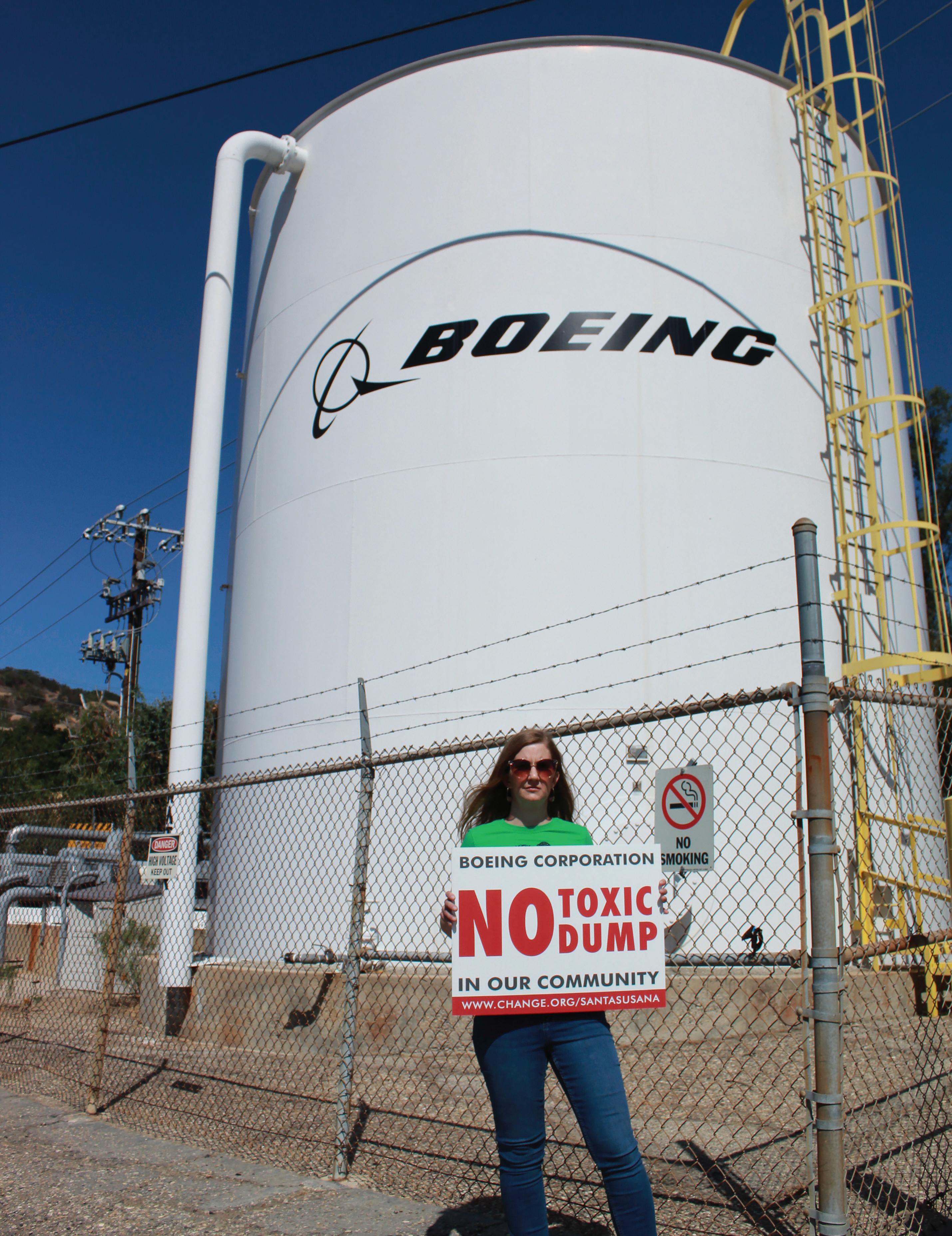
Social Justice 11
Melissa Bumstead holds toxic waste sign outside Boeing’s water tank near Santa Susana Field Lab on Oct. 13.
Photo by Kyanna Hojati.
THE NURSE WITH THE GREEN BANDANA

A nurse who spent summer of 2022 riding the green wave for abortion rights
By Fabiola Carrizosa
With the Downtown Los Angeles city skyline as the backdrop, Rebecca Waite marched over the new 6th Street viaduct chanting bilingually and waving a green scarf in the air.
The modern arches of the bridge represent the future, and so do the green scarves. Trucks honked in solidarity as she and other activists dropped a banner to hang at a busy freeway overpass. Her voice was amplified by other protesters who marched with her.
Waite is a travel nurse who volunteers with RiseUp4AbortionRights.org and an organizer for the Los Angeles chapter.

When the draft decision of Dobbs versus Jackson Women’s Health Organization leaked over the summer of 2022, Waite started to get involved in the movement to legalize abortion nationwide.
“It keeps me up at night. It wakes me up in the morning. I am already an anxious person,” Waite said. “The least I can do is to speak up and say something.”
Originally from Ohio, Waite has been a nurse for 12 years and travel nurse for the last six.
“I was never pro-life,” Waite said.“ I had my opinions formed pretty early in my life. But I was not vocally and strongly pro-abortion until I was 18 or 19 years old.”
What she does for work intersects with her activism, as she has seen women bleed over a table.
“She is a nurse, and she has countless stories from before Roe was overturned of women coming to the hospital and bleeding out with sharp objects inside of them— not knowing how to get an abortion or not having access to one,” said Luna Hernandez, another RiseUp4AbortionRightsActivist.
“I have seen self-induced abortions. Hangers aren’t even the beginning of it,” Waite said.
Social Justice 13
It keeps me up at night—it wakes me up in the morning. The least I can do is to speak up and say something.
“ ”
Rebecca Waite Travel Nurse/Activist
Left: RiseUp4AbortionRights cross the 6th Street Viaduct during a rally in downtown Los Angeles on Sept. 28, 2022. Photo by Benjamin Hanson.
Becca Waite carries a RiseUp4AbortionRights sign on the Venice Beach Boardwalk on Nov. 20, 2022. Photo by Benjamin Hanson.
The Dobbs Decision
In May of 2022, Waite was driving with her firefighter friend up to Redding, Calif., when she looked at her phone and saw reports of the Supreme Court draft leak.
“I just remember this feeling of sinking and doom. It gives me chills thinking about it now,” Waite said. “There is the realization that this is happening and there is a very real chance that Roe was going to be overturned.”
Shortly after that, she went to a Long Beach march and met people from RiseUp4AbortionRights. She went to a Long Beach action and met volunteers with the group who said that they needed more people.
Formed in January of 2022, RiseUp4AbortionRights saw a vacuum and they saw a demand. It was the only voice that Waite could find that was wanting to fight this decision and not prepare to live in a post-Roe world.

“The draft decision made me sad and scared, but through this collective righteous fury of the women I was working with, I was mad,” Waite said. “We have to do
this thing for women everywhere.” Throughout the summer, Waite protested and marched around the Los Angeles area, including Venice Beach and Long Beach. At the events, Waite and her fellow activists hand out stickers and flyers to people sitting at outdoor cafes and lookyloos.
RiseUp uses the green scarf (pañuelo verde) as was used in the Green Wave in Latin America, where women rallied together on the streets for abortion rights. The green wave in Latin America started in kitchens and living rooms and built in a grassroots fashion.

Hernandez thinks that she and Waite share the strength of not being afraid to challenge people to not become normalized to this.
“She doesn’t mince words when it comes to the reality of what
it means when abortion illegal,” Hernandez said. “She is very good at making the argument to people that voting is not going to be enough.”
Chelsea Mesa, an activist and a funeral Arranger in Long Beach said that knows how busy Becca is and that makes her want to keep going.
“I love marching with Becca,” Mesa said. “She keeps it light and fun.”
Danica Riedlinger is one of Waite’s friends, and she has seen Waite’s passion for the abortion rights movement.
“She didn’t even go to my birthday party because she was out there protesting,” she said. “She texted me on my birthday right after Roe versus Wade got overturned and said, ‘Hey girl, I am not going to make it to your birthday. I am protesting in Downtown L.A.’ I feel like that was the best present she could have given me.”
14 thebullmag.com
Above: Becca Waite places RiseUp4AbortionRights sticker on the Venice Beach Boardwalk on Nov. 20, 2022. Photo By Benjamin Hanson.
Left: Becca Waite leads a march in Downtown LA on June 24, 2022. Photo by Fabiola Carrizosa.
Right: Becca Waite carries a RiseUp4AbortionRights sign on the Venice Beach Boardwalk on Nov. 20, 2022. Photo by Benjamin Hanson.
An Uncertain Future for Women
Waite said that most people know someone who has had an abortion, as an average of one in four women get abortion care.
“The people and the entities that have worked hard to overturn Roe and take away abortion rights have the purpose to knock back women and to take away the ability for them to control their futures,” Waite said.

Pierce College history professor Sheryl Nomelli teaches the Role of American Women class.
“This is a really controversial topic for a lot of people who have been raised with religious ideology that makes them question their morality and ethics of terminating a pregnancy,” Nomelli said. “What I tell my students is that no matter how you personally feel about whether you could or should end a pregnancy with abortion, you have to ask yourself— is it your right to impose your personal decisions on every other woman in the country?”
Waite said that she was raised very Catholic with conservative and religious parents. Waite no longer holds those religious beliefs she was raised with.
“A lot of the contradictions and a lot of the bigotry that I see in the name of religion has really turned me away from religion,” Waite said. “I respect that for people. I think that the big thing about bringing religion as a reason to be against abortion is that it is your religion.”
Waite said that the people that have been affected before the Dobbs decision are the most greatly affected now.
“People who already lived in abortion deserts, the undocumented folks, women who are incarcerated or women
who live in abusive or controlling relationships,” Waite said. “They already didn’t have the ability to access the care and abortion services that they needed.”
A lot of the biggest mainstream organizations like Planned Parenthood and a lot of abortion funds want to focus on funding abortions and making abortion pills accessible.
Waite feels like there is a lot of passivity with the abortion rights community, and they are conceding defeat of living in a post-Roe world of abortion pills, abortion funds and voting.
“None of those things have ever been enough,”Waite said. “Suffragettes didn’t even win the right to vote through voting.”
Waite supports that argument by using the stop the steal movement, where radical right wingers refuse to accept the results of elections.
On top of voting, she believes there are other ways to fight for abortion rights, including conversations with friends and family, photography and creating flyers, art, posters and TikTok videos.
Waite also said that they are always looking for graphic designers and for people in sciences who can write or speak out to spread the green wave.
“To me there is no action too small,” Waite said. “Anybody that speaks up and cares about a cause is an activist.”
Social Justice 15

16 thebullmag.com
“ The draft decision made me sad and scared, but through this collective righteous fury of the women I was working with, I was mad. We have to protest for women everywhere.”
-Rebecca Waite
Right: Rebecca Waite in Venice Beach, Calif., on Nov. 20, 2022. Photo by Benjamin Hanson.
https://www.plannedparenthood.org/
Locations nationwide
Birth control, pregnancy and testing services, abortion referals abortion services, Emergency Contraception (morning after pill, HIV Services, men’s health, transgender hormone therapy, women’s services and STD testing treatment and vaccines
https://www.exposefakeclinics.com/ According to Insider.com, fake abortion clinics outnumber real ones three to one. Find the fake ones. Avoid Crisis Pregnancy centers by checking exposefakeclinics.com and report any new ones that are not listed
https://www.plancpills.org/ Plan C provides up-to-date information on how people in the U.S. are accessing at-home abortion pill options online
Abortion Resources
https://www.aafront.org/ One stop shop for up to the minute news on abortion, tools and resources, actions and events
https://www.prochoiceamerica.org/ A non-profit organization that holds political actions, fundraises and advocates to expand access to abortion and birth control and to oppose restrictions on abortions
https://votolatino.org/issues/reproductive-justice/
According to PBS.org, black and brown women — often poor — will likely have the hardest time traveling to distant parts of the country to terminate pregnancies or raising children they might struggle to afford in a post Roe America. Find abortion rights groups, actions and places to donate on this site
https://www.amnesty.org/en/what-wedo/sexual-and-reproductive-rights/ abortion-facts/
Key facts on abortion
Social Justice 17



Clouds loomed as people began to gather in the grass at Pershing Square. However, as the crowd grew to about 20,000, the gloomy overcast dispersed and the sun shined brightly as the march to City Hall began. They carried Iran flags, signs and photos of Mahsa Amini. They shouted “Zan! Zendegi! Azadi!” and “Freedom for Iran!” They sang “Baraye,” by Shervin Hajipour. Thousands of people filled the streets of Downtown LA on Oct. 1, in support of women’s rights everywhere and to protest the Islamic Republic of Iran. Amini was arrested by the Guidance Patrol, Iran’s religious morality police, for not wearing her hijab properly and fell into a coma while in their custody. She later died on Sept. 16.
Since then, there have been many protests and rallies all over the world.
Artists Samantha Rose Moshiri and Yadviga Krasovskaya ended the Oct. 1 rally with a performance that featured Krasovskaya cutting her hair and Moshiri pouring fake blood over herself as the crowd cheered in support.

“I was crying,” Moshiri said. “I was electrocuted by the pain, the anguish,
the despair and the cry for help and the prayer for hope in all these eyes looking at me but not seeing me; seeing the injustice that was happening to women.”
Krasovskaya said that while cutting her hair didn’t change her life, she felt deeply connected to all the women who have done so in Iran to protest their government.
“It was hope and freedom,” Krasovsksaya said. “I’m able to cut my hair and I have a right to that.”
Krasovskaya said that sometimes it feels like there are not enough human rights activists, but seeing and hearing the roar of the people changed those feelings.
“There’s so many of us, and we’re all on the same page. We’re not alone,” Krasovskaya said. “Everyone was there for different individual costs, but they’re all here for the same big reason.”
Computer scientist Nooshin Meshkaty helps to organize the rallies. She coordinates with volunteers, prospective cities and their police departments to ensure the protests run smoothly.
Meshkaty left Iran when she was 15.
“Life was completely different there then,” Meshkaty said. “My life there was no different than my life here now.”
Meshkaty, a selfproclaimed community activist, said that it took more than 100 volunteers to help control the thousands of
Story by Benjamin Hanson & David Pashaee Photos by Benjamin Hanson
Above, people march under an Iranian flag.
Below left, Ryan Mosse looks at the crowd while his 5-year-old son, Rocky, takes a photo.

Below center top, thousands of people march from Pershing Square to City Hall.
Below center bottom, Sophia Amiri protests as “#MASHAAMINI” is painted across her back.

Below right, Yadviga Krasovskaya looks at the crowd after cutting her hair.
demonstrators.
“It was amazing to see so many people caring to rise up and be the voice for people in Iran,” Meshkaty said. “To carry their message and try to bring awareness to the communities around us.”
Meshkaty said there has been a rally every week since Amini’s death in September and they will continue until Iranians regain the freedom they lost in 1979 when the Islamic Republic took over.

Preceding page, Samantha Rose Moshiri (right) covers Yadviga Krasovskaya’s mouth during a performance at the end of the Freedom for Iran rally.
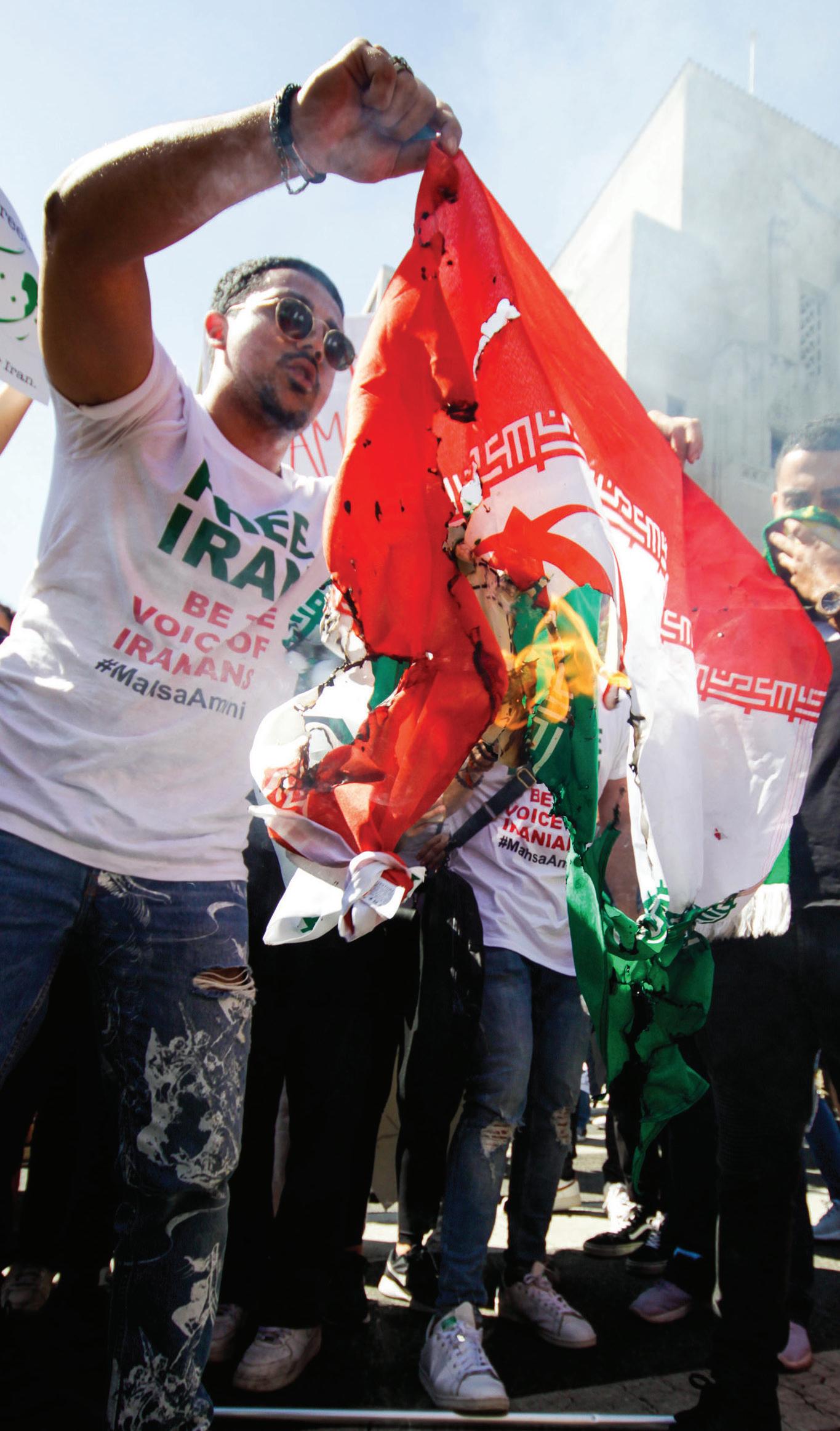

 Left, Amir Malek Ghorban Nejad raises a burning Islamic Republic of Iran flag.
Left, Amir Malek Ghorban Nejad raises a burning Islamic Republic of Iran flag.
Iranian Unity In Pierce College
 Story by Kyanna Hojati
Photos by David Pashaee
Story by Kyanna Hojati
Photos by David Pashaee
On Sept.16, a 21 year old woman named Mahsa Amini died after a violent encounter with the morality police of Iran.
Her crime: showing too much of her hair. Her death would go on and symbolizes the rebirth of the Iranian people, sparking a revolution to overthrow the Republic of Iran that has reigned for decades.
Mitra Hoshiar, Professor of Sociology at Pierce College, is one of the many Iranians living outside of her motherland. She, like many others who are concerned for the well being of the Iranian citizens, is seeking to help those fiercely protesting in the streets.
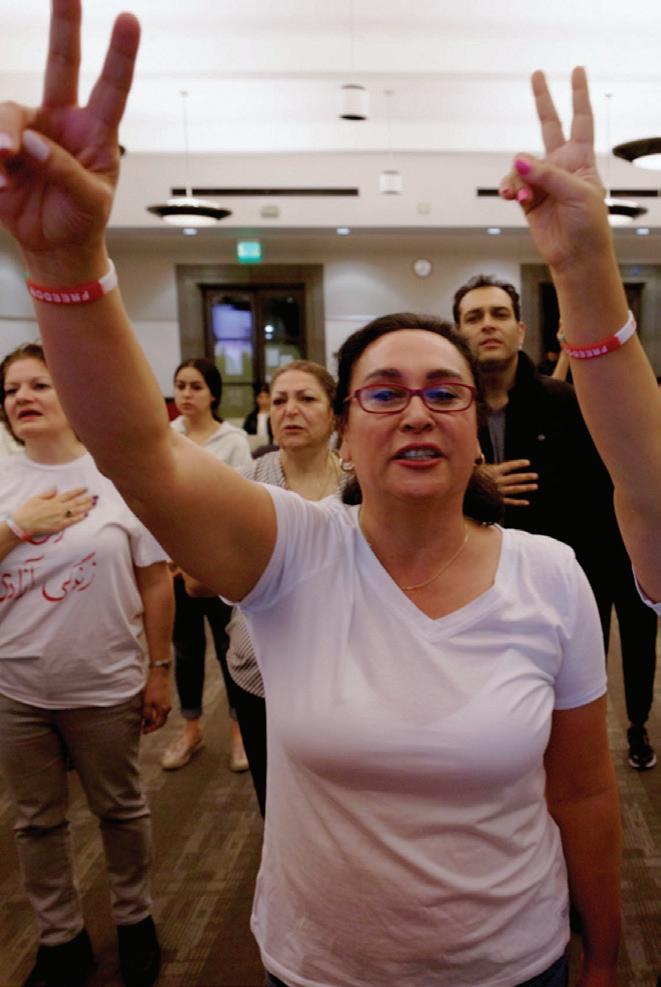
Professor of Sociology Mitra Hoshiar organized a campus event on the 3rd of October to encourage students, faculty and community members to stay vigilant in their advocacy for Iran and to also encourage those around them to
share in the conversation as well.
When talking to community member Hossein, he explained the need for events such as this, whether it requires marching in Pershing Square or simply conversing about ongoing issues and trying to find solutions. “So that we too can show them solidarity.”
The event discussed various ways to continue aiding the Iranian people with advocacy. Whether it be through posting on social media, organizing protests for different regions, or just wearing shirts to bring attention to the issue, everything plays a role in continuing the life of the movement.
“For those of us living outside of Iran, we’ve been acting as cyber soldiers,” said Hoshiar.
Events such as these are what has aided in the continuation of protests well past the 47th day of Mahsa Amini’s death. Hoshiar insists that this movements is not just about Iran, but shares in an overarching theme about how women have been historically oppressed, and their bodies being in constant conversations for different political debates.
“When something happens in
one part of the world, it is our issue as well,” Hoshiar said.
Hoshiar also invited world renowned Iranian singer-songwriter Morteza Barjesteh to speak at the event. Barjestah, who fled Iran two years after the revolution, shares in the concerns regarding those living in Iran.

“We now know that even a single person can change everything,” Barjesteh said.
A single person like Mahsa Amini.
Story by Kyanna Hojati
Social Justice 21
Photos by David Pashaee
Iranian singer-songwriter Morteza Barjesteh holds his hand over his heart.
People attend the Iranian vigil event hosted by Mitra Hoshiar.
Mitra Hoshiar holds a peace sign.

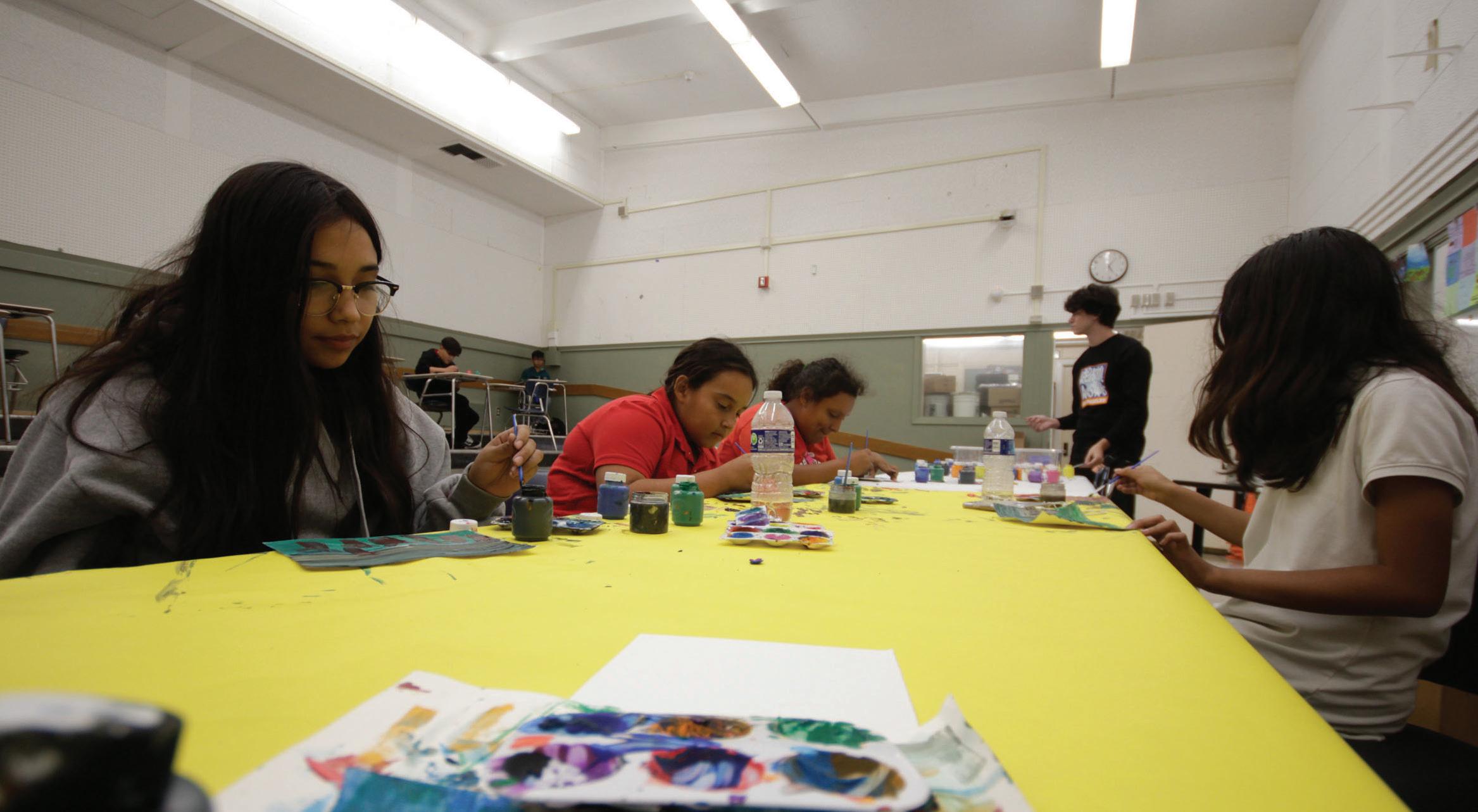
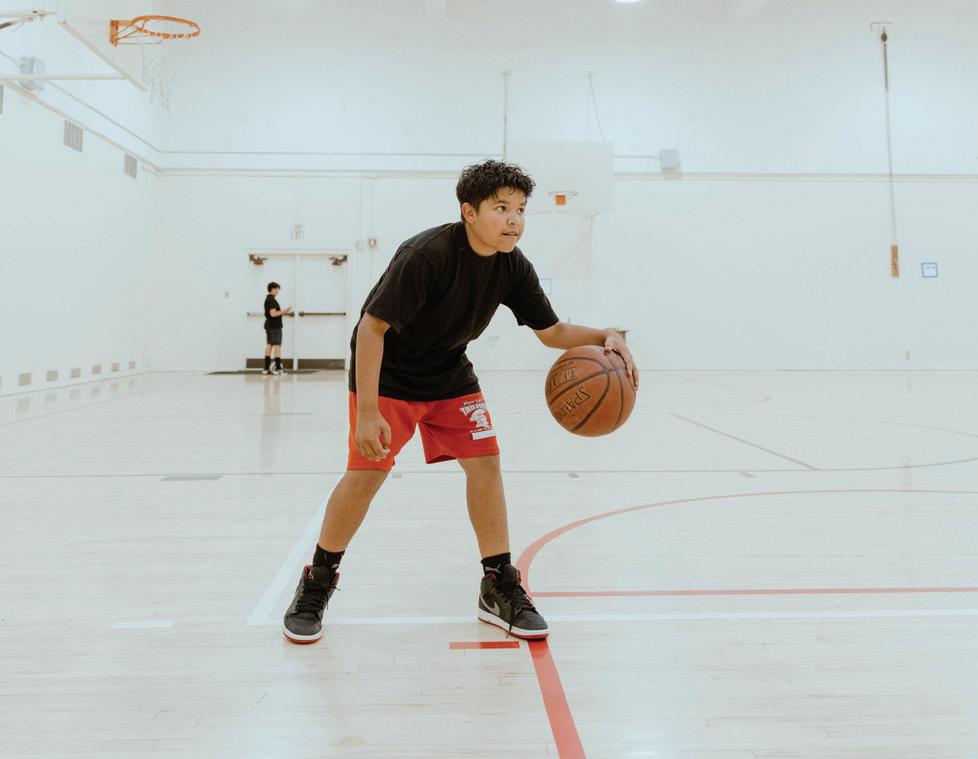
 Joshua Maldonado plays baskeball at Porter Middle School on Oct. 13, 2022. Photo by David Pasahee.
Trineil Roberson plays baskeball at Porter Middle School on Oct. 13, 2022. Photo by David Pashaee.
Katie Burton, center, teaches students how to hold someone up for a cheer routine on Oct. 13, 2022. Photo by David Pashaee.
Joshua Maldonado plays baskeball at Porter Middle School on Oct. 13, 2022. Photo by David Pasahee.
Trineil Roberson plays baskeball at Porter Middle School on Oct. 13, 2022. Photo by David Pashaee.
Katie Burton, center, teaches students how to hold someone up for a cheer routine on Oct. 13, 2022. Photo by David Pashaee.
An Allstar Organization
After-School Allstars seeks to “Educate, Enlighten, and Inspire” the youth
Story by Jennifer Tanzil
Photos by David Pashaee and Benjamin Hanson
At 3:03 p.m. most students at Porter Middle School in Granada Hills are headed to bright yellow school buses or piled into their parents’ cars at the front of the school after dismissal.
But some 100 students headed to the campus’ west end, where they are enrolled in After-School Allstars, a program that meets weekdays.
Walkie-talkies in hand, coaches greeted the students for the day and ensured everyone checked in. Excited chatter filled the covered cafeteria as the middle schoolers enjoyed free snacks.
Program coordinator Christopher Martinez assisted four other program leaders as they supervised students through homeroom (homework time) and clubs, such as painting, photography, cooking, cheer and drama.

“What we’re looking to do here is to cultivate experiences for these kids,” Martinez said.
In a time when families are plagued by inflation, high gas prices and worldwide worries, After-School Allstars-Los Angeles (ASAS-LA) provides a space for kids to be kids while they still can.
“We are a support system
for families,” Martinez said. “Kids deserve an engaging program to have fun.”
Founded in 2002 by then-Gov. Arnold Schwarzenegger, AfterSchool Allstars is a nationwide non-profit organization that provides free after-school services for K-12 students with “the greatest needs and fewest resources.” They’ve partnered with more than 50 schools across Los Angeles County, including three in the San Fernando Valley. One of those schools is Porter, which runs from 3-6 p.m., five days a week. While other after-school programs, such as Beyond the Bell and LA’s Best focus on physical activities, ASAS-LA is more arts oriented. The program structures its programming around four pillars: Academic and Homework Help, Visual and Performing Arts, Health, Fitness, and Nutrition, and Youth Leadership and Community Service.
For eighth grader Alexis Y-Paz, ASAS-LA gives her an opportunity to learn new things and develop greater social skills. “I like the program because everyone is friendly here. I feel really comfortable. The program helped me talk to more people. I’ve made close friends here.”
The 13-year-old particularly likes her photography and art clubs.
“In photography, I learned to take good pictures. I also learned to draw better pictures in art. They’re both very fun clubs,” she said.
A typical ASAS-LA session starts right after school is dismissed. Students are divided into grades and spend about an hour clicking on their schoolprovided Chromebooks finishing their homework.
Then, it’s time for clubs to start. The different clubs meet twice a week, every other day. The program leaders are challenged to
Social Justice 23
“Kids deserve an engaging program to have fun.”
-Christoper Martinez, Program Coordinator
LEFT: Students paint at Porter Middle School in Granada Hills, Calif on Oct. 12, 2022. Photo by Benjamin Hanson
RIGHT: Christopher Martinez at Porter Middle School in Granada Hills, Calif. on October 13, 2022. Photo by David Pashaee.

24 The Bull
contain the excited students who are anticipating what they’ll be doing.
Program leader Katie Burton is in charge of the cheer and drama clubs. She sees the rewards that such engaging clubs bring.
“In drama, I can see the kids gain confidence and gain social skills. It essentially sets them up for future careers,” Burton said.
Burton also said ASAS-LA is an opportunity for low income students.
“When these programs are free, there’s no stress,” she said. “It provides them a chance to learn new activities and gain new interests while helping them stay out of trouble and out on the streets.”
It can be costly for families to enroll their children in out-of-school extracurriculars, such as sports and arts classes. Along with enrollment fees also come transportation costs, the time it takes to drive the kids to each location and equipment fees

According to ASAS-LA’s website, 87% of students enrolled in the program are low-income children who qualify for free or reduced cost meals at school. This was before LAUSD’s recent ruling that free meals will be provided for all students for the 2022-2023 school year, regardless of income. Also, 98% of students in ASAS-LA are young students of color in inner-city schools.
The number of children in Los Angeles County who are low-income and deserving of free programs exceeds ASAS-LA’s numbers.
“I feel like that is essential to a community,” said Director of Child Development at Pierce College Melissa Brisbois. “You need to be offering all children an opportunity to grow, to express themselves. It can’t all just be driven by the families that can pay.”
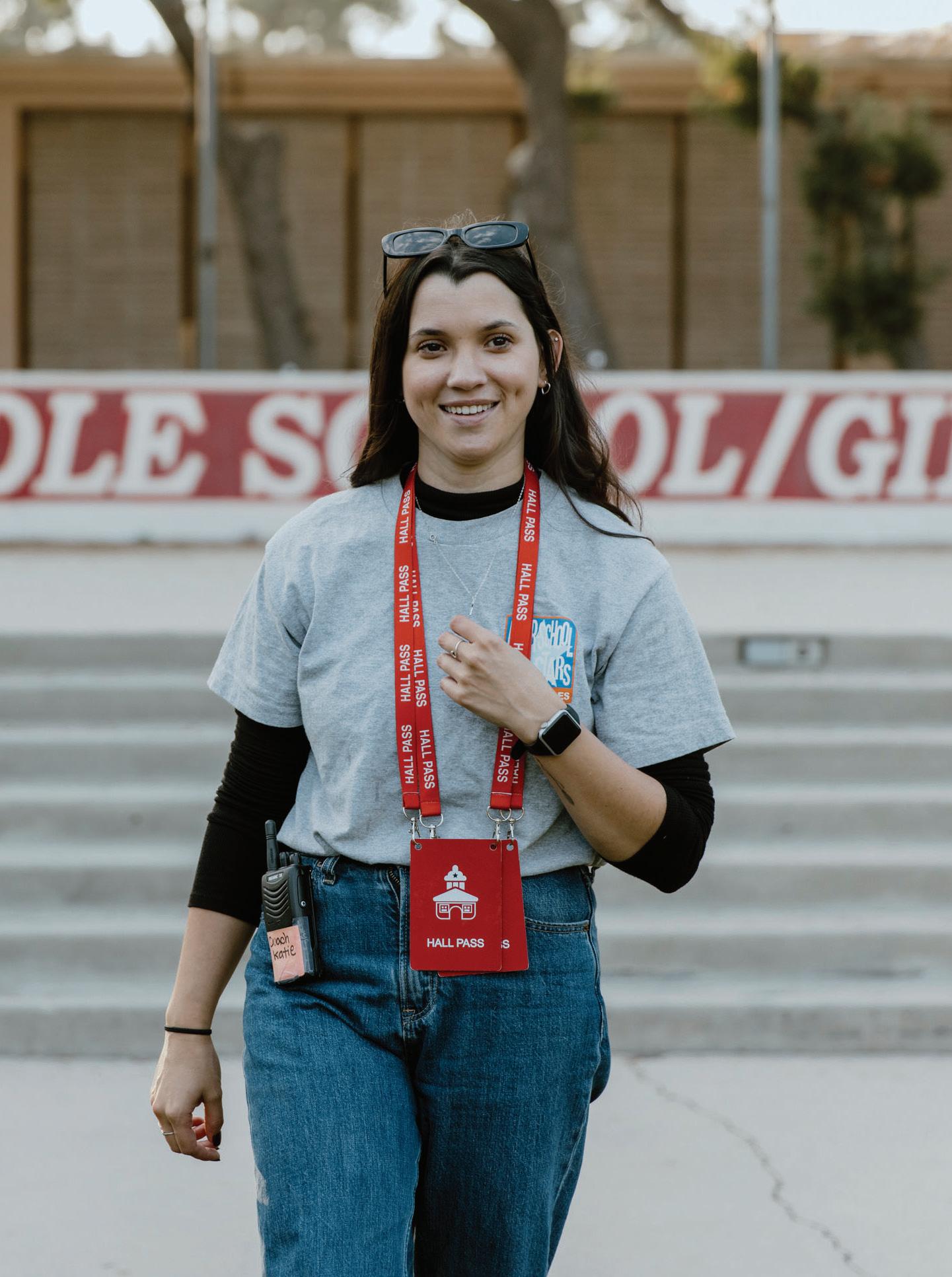
Social Justice 25
LEFT: Janelle Gomez is lifted by students during a practice cheer routine on Oct. 13, 2022. Photo by David Pashaee
RIGHT: Paint and brushes on a table on Oct. 12, 2022. Photo by Benjamin Hanson.
Katie Burton at Porter Middle School on Oct. 13, 2022.
Photo by David Pashaee.
Brisbois offers free preschooling to the children of Pierce students, so they don’t have to worry about who is watching their children as they attend class. This is similar to what after-school programs are doing for LAUSD parents. Brisbois also said that when free programs are offered to communities, it gives everyone an equal opportunity.
“It doesn’t have to be focused on what the art is in the end. It’s about giving children the opportunity to experience these things that not everyone can experience and a safe space to do it,” Brisbois said
When it’s time to get picked up from their after-school programs, students often leave with smiles and the memories of what they’ve learned and experienced throughout their activities.
Seeing students leaving happily is rewarding for Martinez, who has been working with students at various after-school programs for nearly five years. For him, it’s personal: growing up, he was

encouraged by the adults at his school who told him he had the power to do what he wanted to do. He sees working at the organization as a way to pass that message forward.
“My favorite thing about working here is giving back for what was given to me. I want to give back what I experienced,” Martinez said.
A few miles down the road from Porter, Michael Silva leads a similar after-school program called Keep Youth Doing Something (KYDS) for low-income students at Monroe High School in North Hills. As program coordinator, Silva oversees clubs such as mariachi club, hip hop club and even an esports group. He takes into consideration how kids from certain walks of life have different experiences as soon as the school day ends.
“Some of these kids are forced to go home, to go to work, or to help their parents and siblings, for survival’s sake. You see it and you can’t help but feel bad,” Silva said
He knows firsthand as a Latino,
how some Latino parents can stop their children from participating in such programs, instead opting for their children to work or help around the house. Silva reassures families like these that it’s okay to go outside of your comfort zone.
“You want them to have their fun now while they’re young,” Silva said. “The best part of what we do is not asking for anything, and then allowing these kids a chance to play with instruments, play sports and be part of a group.”
They’re two different programs, but the common belief is to give power to the youth and help them grow by enriching their after school experiences at no charge.
“It’s important to listen to the needs of these kids,” Martinez said. “At the end of the day, without them, there wouldn’t be a program.”
Below: Christopher Martinez, right, helps Navaeh Mandujano with her homework in Granada Hills, Calif. on October 13, 2022.
Photo by David Pashaee.
Dean Astorga, Pierce’s Tio
 By Fabiola Carrizosa
Photo By Arwen Domonguez
By Fabiola Carrizosa
Photo By Arwen Domonguez
When Dean Juan Carlos Astorga was in high school, he was not planning to go to college. He changed mind, and while there he switched his major seven to eight times. He thought he was going to be a mathematics or chemistry major. He even wanted to be an engineer, as it seemed like they drove nice cars and made money. Then, one summer, he worked at Hewlett-Packard as an intern alongside other engineers, where he realized that the lifestyle was a hard ‘no’ for him.
“I started to try to figure out what was a better fit for me. I never thought that I was going to be a dean, ever,” he said.
The Dean of Student Engagement at Pierce College since 2015 knows that learning happens outside of the classroom as much as inside. He encourages and challenges students to do things that they may have never done, such as watching plays, listening to TED Talks and talking to individuals outside of their backgrounds.

“If we have gotten students to think about the world in a different lens that compliments who they started off as, or that has challenged you to look at the world differently, we have done our job,” he said.
Astorga was born in Tecate, Baja, Mexico. At the age of 4, he and his family immigrated to San Diego.
Astorga attended the University of California San Diego by way of Affirmative Action.

“I wear that proudly as a badge of honor,” Astorga said. “It was an opportunity to show my potential and to find my voice while I was an undergrad at UC San Diego.”
Next, Astorga attended Cal State Fullerton where he got his doctorate. His research there was on undocumented students because he wanted to create spaces for them.
When he was hired as dean in 2015, his job was to oversee the First Year Experience Center, the library, the student leadership, clubs and organizations, the peerto-peer mentor program as well as leading all leading disciplines for the campus.
“My goal was to really establish sacred and safe spaces for students to find their voice
and utilize that voice for their empowerment and to make an impact and to leave an imprint on this campus,” Astorga said.
“He’s a very cool guy. Even though he is very busy, he always has time for the students and for us at senate,” said Caden Antonio Lewis, a Veterinary Science major and member of the ASO Senate.
Astorga said that within the last five years, there has been a shift on the campus. The Chicano and Latino student population has risen to 52 percent. At the Federal level, Pierce is considered a Hispanic Serving Institution. As an HSI, the college is eligible to apply for certain grants.
When Astorga first started at Pierce, he connected with Chicano Studies professor and M.E.CH.a adviser Angelita Rovero.
“We started to dream of some of the things that we could do. Little-by-little we worked together, and we started to see the support from the administration,” he said.
Astorga and Rovero brought the Dia de los Muertos celebration to Pierce as well as a cultural and musical event called Flor y Canto. Most recently, they have put on the first Annual Hispanic/Latino Heritage Month Series featuring musical performances and speakers.
“I see him as a mentor,” said Automotive Service Technology Professor Alex Villalta. “He has not only opened doors for me, but for my students.”
Social Justice 27
“Poco a poquito (little by little), we land into the places we are meant to be. ”
Dean Juan Carlos Astorga
Left: Dean of Student Engagement Juan Carlos Astorga smiles in front of a green Chevrolet pickup truck at the Advanced AutoTech Building in Pierce College on Oct. 20, 2022.

28 thebullmag.com
Geremy Mason displays a variety of food and snacks from the Brahma Bodega that are available to students at Pierce College in Woodland Hills, Calif., on Wednesday, Nov. 16, 2022.
Photo by Raquel G. Frohlich.
Meeting basic needs
Pierce College program helps students with food and other resources
Story By Poupy Gaelle Nguetsop
Photos by Raquel G. Frohlich and PoupyGaelle Nguetsop
After escaping what she called an abusive home, Morgan Parker started college— majoring in psychology—and she had a job at a fitness center.
Then it all changed.
“I got fired from my job today and have no job now,’’ she said. “I’m very stressed out and scared. I relied on my job. I’m trying to figure it out and don’t know what to do next.’’
Now living in a hostel in Downtown Los Angeles that cost $24 a night, her situation is becoming dire.
“I’m going to donate my plasma tomorrow and get money from it. It’s the only way to get cash,” she said. “Then I will open a P.O. box to prove residency, get an ID and file for unemployment.”
Parker is part of the one in 10 Americans 18-25 years old who have experienced homelessness, according to a University of Chicago study. And The Washington Post reported earlier this year that inflation is dramatically increasing the homeless population, which is nearly 600,000 nationwide.

The University of Southern California Economics professor James Meza-Cordero said inflation has a huge impact on the poor people because they have to spend all of their money buying goods and services, while rich people are investing theirs.
At Pierce College, teachers and administrators are assisting students in situations similar to Parker’s

Geremy Mason heads The Brahma Pantry and Basic Needs
Program, which provides students with access to food, ongoing motivational support and referrals to agencies that are designed to meet students’ physical, psychological, emotional and economic needs.
He said meeting basic needs for students is vital.
“We all need food to eat and a place to feel safe in order to function our best,” he said. “Students experiencing financial hardship tend to find it much more difficult to continue with their studies. It’s hard to focus on the quadratic formula if you’re worried about what you’re going to eat today.”
Loy, who held the position before Mason, agrees.
“It’s important to students because once basics need are met with the students they will be able to learn better,” he said. “We see that in college. We don’t only care about the academy part of student’s journey, but we also care about the wellness of the students, when they are fed. When they are feeling happy and satisfied and fulfilled, then they will be able to learn better, and we think that their conditions in their life really assist their living condition or their learning condition in the classroom.’’
Loy explained the ways Mason and others at Pierce are helping with those needs, which was something he could have used when he was in school.
“They are holding food events, where students are able to come pick up a meal,” he said. “When I was in college, I had difficulty. I went through food insecurity. I would take the bus to school.
Sometimes I didn’t have enough money, because I wasn’t paid that well at my job. And some days I had to sacrifice and not eat all day.
Mason hopes those on campus won’t struggle the way Loy did.
“The resources that we provide can make a world of difference to students in difficult circumstances and ensure that they stay on their educational paths,” he said.
Right:Morgan Parker who lives in a hostel on Oct. 12, 2022. Photo by Poupy Gaelle Nguetsop.
Robert Loy at Pierce College in Woodland Hills, Calif., on Wednesday, Nov. 16, 2022. Photo by Raquel G. Frohlich.
RUINING THE RUNWAY ROUTINE
They’re leaving on jet planes, but first they have to get through a pink 12foot wooden structure, 20 people singing John Denver while throwing paper planes at each other and a little brown poodle named Maisie.
The LA chapter of Extinction Rebellion blocked the entrance to Netjets, a private jet company, for six hours on Nov. 10.
The activist group protested the use of private planes in support of similar coalitions around the world. Their goal was to disrupt
the wealthy’s runway routine for as long as possible to bring awareness to the amount of private jet emissions.
University of Southern California professor Joshua Goldstein donned a scientist coat as he stood, chained to the pink structure.

“The world, at this moment, cannot afford this,” Goldstein said. Only 1% of the world’s population travel by private jet, yet they account for 50% of aviation emissions, according to Transport & Environment.
“We’re doing it to call out that consumption and to insist on what they’re saying in COP27,” Goldstein said. “The rich have to pay their share.”
In Sharm El-Sheikh, Egypt, 100 world leaders met for the 27th Conference of Parties. The purpose of the annual summits are to discuss progress made by the United Nations on limiting climate change.
According to Yard.com, in 2022 alone, celebrities emitted an average of 3,376 metric tons of CO2 emissions in private jet use.
30The Bull
USC professor Joshua Goldstein (front), social worker Dylan Kidd (left), CSUN professor Karen Morganie (top) and grant writer Joshua Hirsch chained themselves to a wooden structure. Photo by Benjamin Hanson.
Story by Benjamin Hanson
Photos by Benjamin Hanson & David Pashaee
The average person emits seven metric tons.
Califonia State University, Northridge sociology professor Karen Morgaine sat atop the pink structure. Morgaine said she discovered Extinction Rebellion’s LA chapter through her wife after speaking about the original movement during a lecture.

Morgaine said the best way to get the public’s attention on an issue is by making sacrifices.
“Comfort, time, potentially freedom,” Morgaine said. “Escalating a protest to demonstrate your commitment to your cause is often incredibly effective.”
Former Pierce
College student Patricia Lyon is a member of Extinction Rebellion and helps run the chapter’s social media accounts.

Lyon, a mother to a 3-year-old boy, said she fears the planet is headed to another mass extinction event.
“I’m standing up for all the children of the future because if it gets much worse, we will not have a planet to live on anymore,” Lyon said. “I want people all around the world to wake up to what is happening.”
LAPD and LA Airport police were present, however, no one was arrested as Netjets declined to press charges.
 Members of Extinction Rebellion LA dance and sing along to John Denver’s “Leaving on a Jet Plane” with modified lyrics. Photo by David Pashaee.
Lisa Stumph holds an Extinction Rebellion flag in front of Netjets. Photo by David Pashaee.
LA Airport police officer Karla Rodriguez is reflected in Stephen Starr’s sunglasses as she speaks. Photo by Benjamin Hanson.
Members of Extinction Rebellion LA dance and sing along to John Denver’s “Leaving on a Jet Plane” with modified lyrics. Photo by David Pashaee.
Lisa Stumph holds an Extinction Rebellion flag in front of Netjets. Photo by David Pashaee.
LA Airport police officer Karla Rodriguez is reflected in Stephen Starr’s sunglasses as she speaks. Photo by Benjamin Hanson.
Julio Cortez
Pulitzer Prize-winning Pierce College graduate captures history through photojournalism
Written By Jennifer Tanzil
Photo by Benjamin Hanson
Julio Cortez is a Baltimorebased staff photographer for the Associated Press (AP) whose assignments have taken him from the steps of the U.S. Capitol on Jan. 6, 2021, to the electric atmosphere of the 2016 Rio Olympics.

His roots go through the San Fernando Valley as he worked to obtain his bachelor’s degree by way of Pierce College and California State University, Northridge (CSUN).
His many assignments include the 2020 riots in Minneapolis following the death of George Floyd. It was there that Cortez took the photo that would win him a Pulitzer Prize for Breaking News Photography.
The haunting image shows a protester holding an upside down American flag as he walks in front of a burning building, taken after a long day of demonstrations.
The photo was shared numerous times on social media and became a symbol of the George Floyd protests and racial inequality in America. Cortez hails this as his favorite photo he’s taken.
“The reason why people love it is because they feel what they see and that’s my job.” Cortez said.
Upon receiving the news that he won a Pulitzer, Cortez said he cried as he basked in the “incredible” feeling he found difficult to describe.
“I looked at my kids and said, ‘we’re champions,’” Cortez said.
It was a rare moment for the photographer to be the champion in the situation, as he’s usually the one behind the camera that captures
photos of champions, such as Olympians Usain Bolt and Michael Phelps in his last gold medal ceremony at the Rio 2016 Games.
Cortez said that one of the top three events he’s photographed was the Los Angeles Dodgers during their 2021 White House visit after winning the World Series a few months prior. Being a Dodgers fan, he was amazed to see his favorite team, along with the president and vice president, standing in front of him.
“This is incredible. I’m sitting in this room in the White House with my favorite team, doing something really cool,” Cortez said. “That experience really struck me.”
Despite having photographed famous people at famous events, Cortez doesn’t let himself get starstruck.
“I photograph (notable people) all the time so I know they’re humans. I acknowledge that they’re very talented but I’m never like, ‘Woah. That’s so-and-so.”
Instead, Cortez is more fascinated in the events he’s covering.
Pierce College journalism professor Jeff Favre said, “The best thing about Julio is that as successful as he is, he still considers being a mentor as one of the most important things he can do.”
Cortez recently did a presentation for Pierce College students, telling them of his experiences and giving tips to photography students.
His words spoke to photography student Raquel Frohlich, who said it was “such an experience” to be able to hear Cortez’s speech in person.
“One of the interesting things he talked about is working with a partner,” Frohlich said. “I started doing photojournalism at Pierce during COVID, so I didn’t have that experience of working with a partner for a while.”
But being the only AP photographer in Maryland can be a challenge.
“I’m constantly working whether I’m on vacation or not, but I do prioritize my kids when it’s their time.”
32 The Bull
Tia Chucha’s Centro Cultural
Review By Eli Manzanares
Photos By Raquel G. Frohlich
Tia Chucha’s Centro Cultural is the northeast San Fernando Valley’s first cultural center, bookstore and art gallery that gives back to the community.
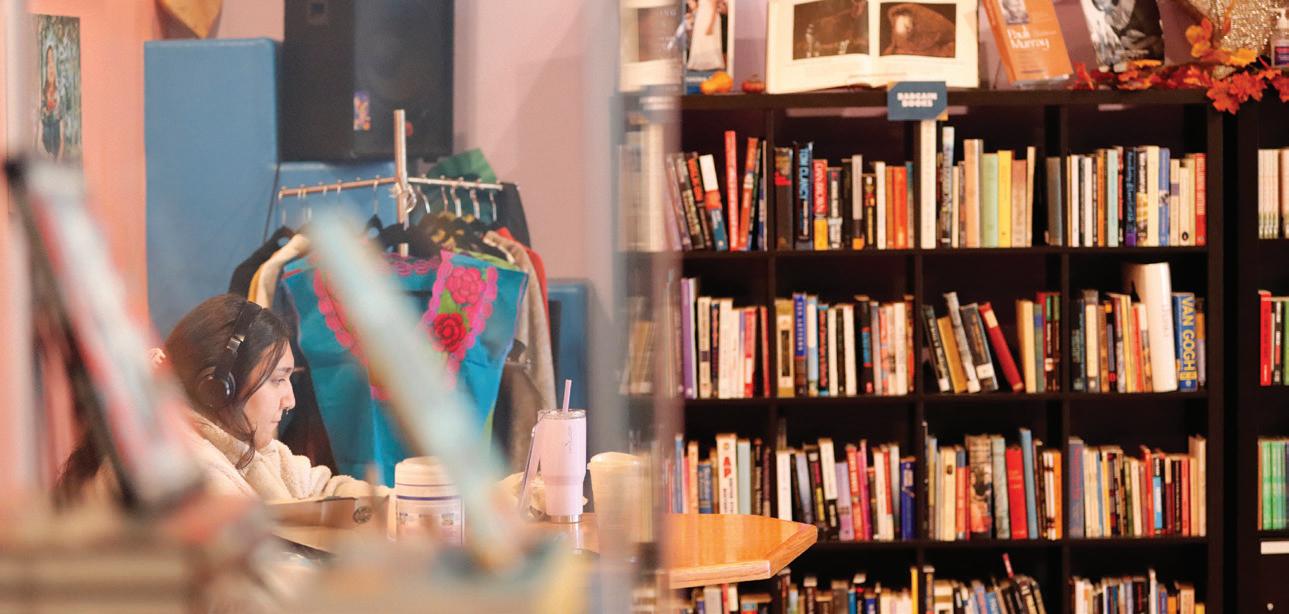
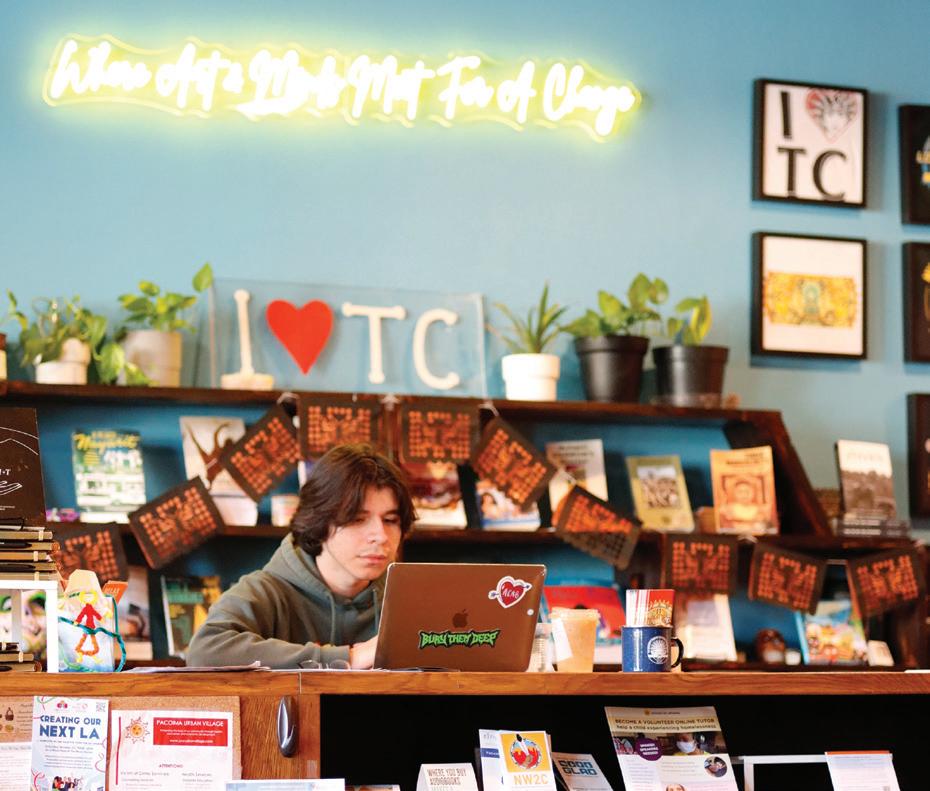
Los Angeles Poet Laureate Luis J. Rodriguez, his wife Trini and brother-in-law Enrique Sanchez founded Tia Chucha’s. Founded in 2001, it has transformed into a nonprofit, year-round center for community outreach.
According to its website, the center offers “off-site free or lowcost arts and literacy bilingual intergenerational programming in mural painting, music, dance, writing, visual arts, healing arts sessions (such as reiki healing) and healing/talking circles. Workshops and activities also include Mexica (“Aztec”) dance, indigenous cosmology/philosophy, and two weekly open mic nights (one in Spanish, the other in English).
Over this past summer, it had a plethora of programs for the local community, including guitar lessons, photography classes, healthy cooking and water painting.
Supplies for these classes were offered by the center, so that those taking classes did not have to worry about out-of-pocket expenses. The center also has a publishing wing in which local poets can submit poems to possibly be placed into their books. Tia Chucha’s releases a book with these poems twice a year, giving writers time to piece together their work for submission and competition.
On a yearly basis, Tia Chucha hosts the annual Celebrating Words Festival, where new books are distributed for free, live performers showcase their art, creative workshops, community resources and local food vendors of all types.
Another program started by the center that has had a large and important impact on the community is “From Trauma to Transformation,” or T2T, in which formerly incarcerated women and men of all ages in the Los Angeles area are able to share their experiences. Through spoken word, writing, poetry, oral histories, memoirs and theater, T2T is able to provide a space to honor and amplify the
voices of those who have been behind bars.
Giving back the humanity of those who have been deemed unable to change and are once a criminal, always a criminal, T2T allows the general public to experience the true stories of those who have suffered at the hands of the American criminal justice system. It gives the people a platform to tell their stories and be able to move past those barriers they had been set behind.
Tia Chucha’s also has opportunities for employment and volunteer work, giving everyone in the community a chance to work toward the preservation of the arts and culture.
Location: 12677 Glenoaks Blvd., Sylmar, CA 91342
Hours:
Monday-Friday 11a.m. - 9p.m., Saturday: 11a.m.-8p.m., Sunday: 11a.m.-4p.m. tiachucha.org
IG: @tiachuchas
Contact: (818)939-3433
Social Justice 33
ABOVE: Literary event coordinator Jackie Garcia at Tia Chucha’s Centro Cultural & Bookstore in Sylmar, Calif., on Tuesday, Nov. 15, 2022. RIGHT: Bookstore attendant Joey Rodriguez at Tia Chucha’s Centro Cultural & Bookstore in Sylmar, Calif., on Tuesday, Nov. 15, 2022. Photos by Raquel G. Frohlich.
Pierce College Student Resources
Student Health Center
A free health and wellness resource for Los Angeles Pierce College students.
Free Family Planning and STI Services to qualified students
2nd Flr., Student Services Bldg.
6201 Winnetka Ave, PMB 345
Woodland Hills, CA 91371
(818) 710-4270
(818) 713-8022 Fax
Disabled Student Program & Services
Provides services to students with disabilities.
For ASL Interpreter request, please email: special_services@piercecollege.edu - Please include your First, Last Name & Student ID Number. Student Services Building, 1st Fl.
Email: special_services@piercecollege.edu
Office: (818) 719-6430
VP: (747) 226-5739
UMOJA
IG: @umojapiercecollege
An academic learning community and resource dedicated to enhancing the cultural and educational experiences of African American students and others.
Umoja Village
Library & Learning Crossroads
LLC 5113
(818) 710-3302
Dream Resource Center
IG: @lapc_dreamers
Supports undocumented students on their educational journey. DRC provides information, resources, and services to ensure students are equipped with the tools to have a successful college experience.
Located in Student Engagement/ASO Center
Office Hours
Monday: 9:30am - 3:00pm(On-campus & Online)
Tuesday: CLOSED
Wednesday: 1:00pm - 5:30pm(Online only)
Thursday: 9:30am - 3:00pm(On-campus & Online)
Friday: 12:30pm-2:30pm(Online only)
Weekends: CLOSED
Veteran Resource Center
Serves Veterans and Veteran Dependents
Veterans Services Office
Los Angeles Pierce College
Student Services Bldg., 2nd fl. 6201 Winnetka Ave.
Woodland Hills, CA 91371
(818) 710-3316
pierce-veteran@piercecollege.edu
CALWORKS Program
Offers a variety of services designed to support educational, career and personal goals for CALWORKS students at Pierce College
CalWORKs Program
2nd Floor, SSB
Phone:(818) 719-6400
34 Social Justice
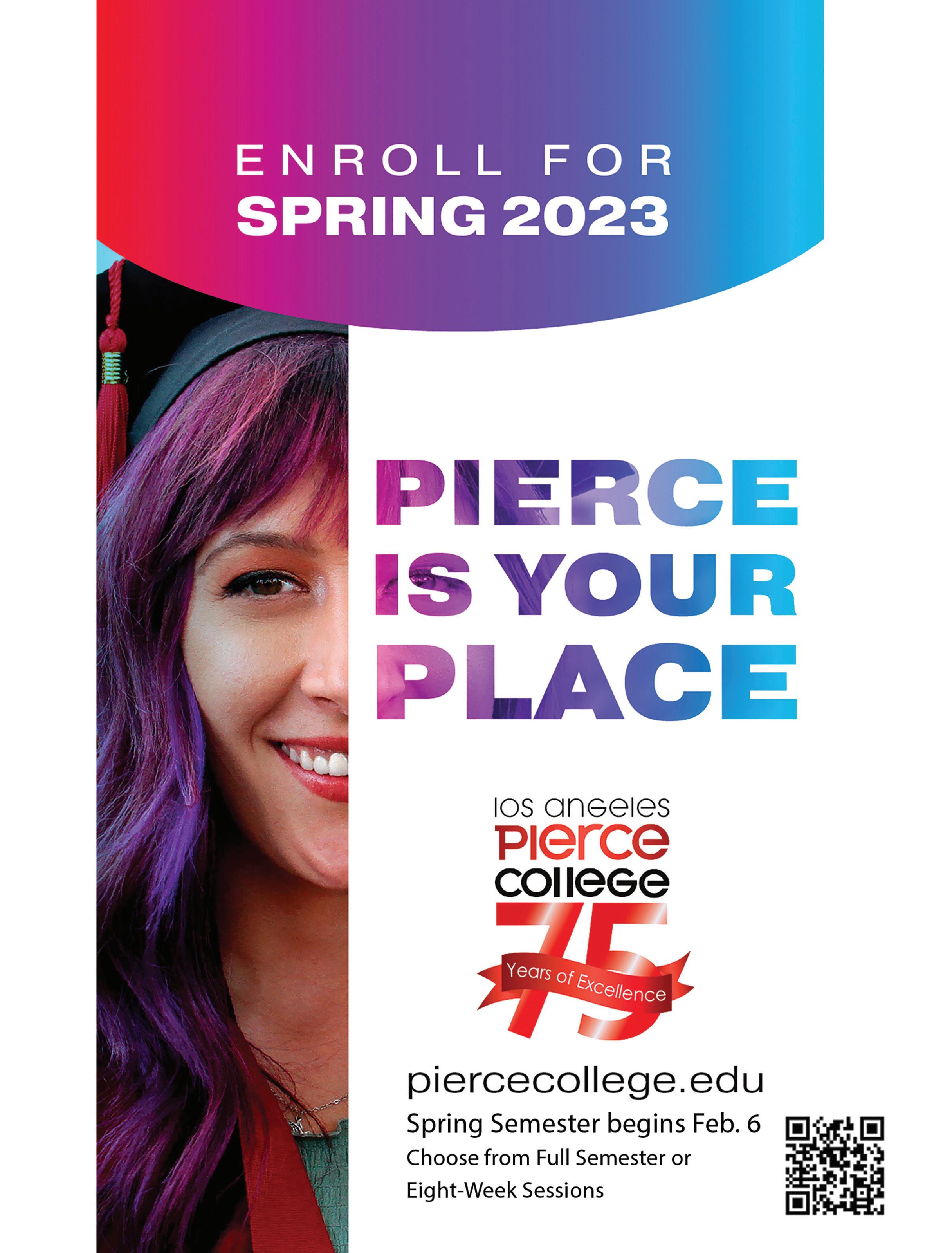

thebullmag.com

 Fabiola Carrizosa
Photo by David Pashaee, June 12, 2022
Front and back covers by Benjamin Hanson
Fabiola Carrizosa
Photo by David Pashaee, June 12, 2022
Front and back covers by Benjamin Hanson













 Melissa and Grace Bumstead look at photos of when Grace was hospitalized. Photo by David Pashaee on Nov. 1, 2022.
Melissa and Grace Bumstead look at photos of when Grace was hospitalized. Photo by David Pashaee on Nov. 1, 2022.
 Story by Kyanna Hojati
Photos by David Pashaee and Kyanna Hojati
Story by Kyanna Hojati
Photos by David Pashaee and Kyanna Hojati





















 Left, Amir Malek Ghorban Nejad raises a burning Islamic Republic of Iran flag.
Left, Amir Malek Ghorban Nejad raises a burning Islamic Republic of Iran flag.
 Story by Kyanna Hojati
Photos by David Pashaee
Story by Kyanna Hojati
Photos by David Pashaee





 Joshua Maldonado plays baskeball at Porter Middle School on Oct. 13, 2022. Photo by David Pasahee.
Trineil Roberson plays baskeball at Porter Middle School on Oct. 13, 2022. Photo by David Pashaee.
Katie Burton, center, teaches students how to hold someone up for a cheer routine on Oct. 13, 2022. Photo by David Pashaee.
Joshua Maldonado plays baskeball at Porter Middle School on Oct. 13, 2022. Photo by David Pasahee.
Trineil Roberson plays baskeball at Porter Middle School on Oct. 13, 2022. Photo by David Pashaee.
Katie Burton, center, teaches students how to hold someone up for a cheer routine on Oct. 13, 2022. Photo by David Pashaee.





 By Fabiola Carrizosa
Photo By Arwen Domonguez
By Fabiola Carrizosa
Photo By Arwen Domonguez








 Members of Extinction Rebellion LA dance and sing along to John Denver’s “Leaving on a Jet Plane” with modified lyrics. Photo by David Pashaee.
Lisa Stumph holds an Extinction Rebellion flag in front of Netjets. Photo by David Pashaee.
LA Airport police officer Karla Rodriguez is reflected in Stephen Starr’s sunglasses as she speaks. Photo by Benjamin Hanson.
Members of Extinction Rebellion LA dance and sing along to John Denver’s “Leaving on a Jet Plane” with modified lyrics. Photo by David Pashaee.
Lisa Stumph holds an Extinction Rebellion flag in front of Netjets. Photo by David Pashaee.
LA Airport police officer Karla Rodriguez is reflected in Stephen Starr’s sunglasses as she speaks. Photo by Benjamin Hanson.




